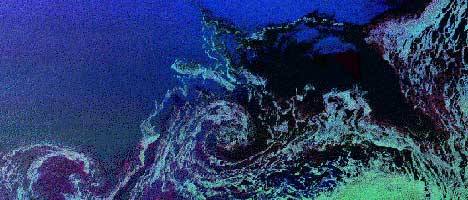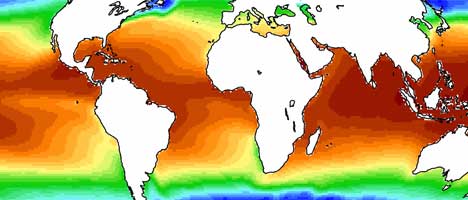Ocean and Ice Processes
The ocean is the predominant reservoir in the earth system for heat and carbon, and ocean circulation redistributes these important components of the climate system around the globe. Dynamical processes on many scales, from basin-wide currents, through mesoscale eddies, down to small-scale turbulent mixing, contribute to the effects of the oceans on climate. In polar regions, ice in the form of ice-sheets on land, or sea-ice in the ocean, influences the climate by modifying albedo. Interactions between the oceans and ice-shelves, icebergs and sea-ice influence the rate of ice melt, sea-level rise and large-scale ocean currents.
Ocean Mixing
Small-scale mixing processes are an important component of the large-scale ocean climate, providing cross-isopycnal fluxes of heat, salt and other tracers. Examples include wind- and buoyancy-driven mixing in the ocean surface layer, instabilities driven by large-scale shear and internal waves in the ocean interior, double-diffusive interleaving, and frictionally-driven processes at the bottom boundary. These processes occur on scales much smaller than the climate model grid-scale, and so must be parameterized (represented in terms of resolved scales) in climate simulations.
Ocean Mesoscale Eddies

Ocean mesoscale eddies are the “weather” of the ocean, with typical horizontal scales of less than 100 km and timescales on the order of a month. The mesoscale eddy field includes coherent vortices, as well as a rich cascade of other structures such as filaments, squirts and spirals. The mesoscale field is characterized by temperature and salinity anomalies with associated flow anomalies that are nearly in geostrophic balance. Although only the surface expression of mesoscale eddies is visible in satellite images of sea surface height or temperature, they are in fact three dimensional structures that reach down into the pycnocline. A special class of eddies, known as meddies (Mediterranean eddies), are predominantly sub-surface lenses of salty water that form off the Atlantic coast of Spain/Portugal from the deep Mediterranean outflow.
Ice-sheet Dynamics
The present-day ice sheets contain the equivalent of about 65 meters of additional sea level, locked in the form of ice. Consequently, even relatively minor changes in the imbalance of the ice sheets have global significance. Two decades of satellite measurements in Greenland and Antarctica reveal snapshots of ongoing ice-sheet change, which imply significant sea-level rise in the next centuries. In order to better understand and constrain the projections of how climate will alter ice sheet evolution and how changes in the ice sheets will influence global climate change in the coming centuries, we need to understand the dynamics of ice sheets and the way ice is discharged from the ice-sheets – interior to their margins – into the surrounding oceans.
Large-scale Ocean Dynamics

Changes in the large-scale ocean circulation, such as the Atlantic Meridional Overturning Circulation (AMOC), have a profound impact on global and regional climate systems, including Sahel and Indian summer monsoon rainfall, Atlantic hurricane activities, and Arctic climate. The large-scale ocean dynamics have played a key role in modern and paleo climate change and low frequency variability in coupled ocean-atmosphere systems. Understanding the dynamics of large-scale ocean circulation is crucial for prediction of low frequency climate variability and future climate change, especially abrupt climate change. Large-scale ocean dynamics also have important influence on the uptake of heat and carbon dioxide by the ocean, and global biogeochemical cycling.
Ice-ocean Interactions
The largest mass loss from both Greenland and Antarctic ice sheets is observed at their margins, in areas where warm ocean waters have access to outlet glaciers and ice shelves. Migration of the grounding line (the boundary between floating ice and ice grounded on its bed), and changes in ice flux through it, result in variations of ice-sheet contributions to sea level. The ongoing changes in the Amundsen Sea Embayment (Antarctica) – increased mass loss, retreat of the grounding line, acceleration of the grounded ice streams feeding floating ice shelves and ice tongues – are attributed to either the direct or indirect effects of the surrounding warm oceans.


